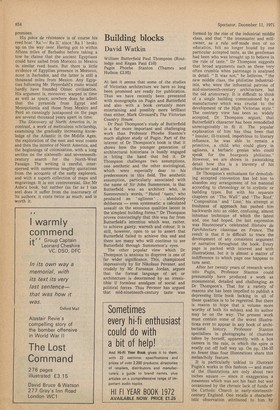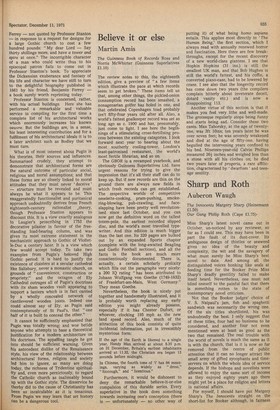Building blocks
David Watkin
William Butterfield Paul Thompson (Routledge and Kegan Paul £10) Pugin Phoebe Stanton (Thames and Hudson £2.95) At last it seems that some of the studies of Victorian architecture we have so long been promised are ready for publication. Thus we have recently been presented with monographs on Pugin and Butterfield and also with a book certainly more entertaining and possibly more brilliant than either, Mark Girouard's The Victorian Country House.
Dr Paul Thompson's study of Butterfield is a far more important and challenging work than Professor Phoebe Stanton's much slighter study of Pugin. Part of the interest of Dr Thompson's book is that it shows how the younger generation of architectural historians is busily engaged in biting the hand that fed it. Dr Thompson challenges two assumptions, one aesthetic and the other sociological, which were especially dear to his predecessors in this field. The aesthetic assumption, particularly associated with the name of Sir John Summerson, is that Butterfield was an architect who, in Summerson's words, "Hated 'taste,' who produced an ' ugliness ' . . . absolutely deliberate — even systematic: a calculated assault on the sensuous qualities latent in the simplest building forms." Dr Thompson proves convincingly that this was far from Butterfield's intention which was, rather, to achieve gaiety, warmth and colour. It is still, however, open to us to assert that Butterfield failed to achieve this end and there are many who will continue to see Butterfield through Summerson's eyes.
The other popular view which Dr Thompson is anxious to disprove is one of far wider significance. This, championed impressively by Sir Nikolaus Pevsner, and crudely by Mr Furneaux Jordan, argues that the formal language of art or architecture is determined by an irresistible if formless amalgam of social and political forces. Thus Pevsner has argued that mid-nineteenth-century taste was formed by the rise of the industrial middle class, and that "the ironmaster and millowner, as a rule self-made men of no education, felt no longer bound by one particular accepted taste, as the gentleman had been who was brought up to believe in the rule of taste." Dr Thompson suggests that broad arguments such as these very often crumble when patronage is analysed in detail. "It was not," he believes, "the new middle class, the philistine industrialists, who were the influential patrons of mid-nineteenth-century architecture, but the old aristocracy. It is difficult to think of a single building commissioned by a manufacturer which was crucial to the development of the High Victorian style." The contrary view has been so widely accepted, Dr Thompson argues,' that Butterfield's character has been remodelled unrecognisably to fit it. The popular explanation of him has thus been that " Insular, ill-trained, impervious to literary influence, he was able to remain a primitive, a child who could glory in ugliness, a barbaric genius who could speak for the bourgeois philistine." However, we are shown in painstaking detail how this is a travesty of his character and aims.
Dr Thompson's enthusiasm for demolishing accepted convention has led him to abandon any arrangement of his material according to chronology or to stylistic or building types. But with his separate chapters on 'The Wall' and 'The Roof,' '
Composition' and 'Line,' his attempt at freshness of approach has pushed him backwards into an older, confusing, almost inhuman technique of which the latest and, one had hoped, the last expression was Hautecoeur's celebrated Histoire de Parchitecture classique en France. The result is that it is difficult to trace the development of any consistent argument or narrative throughout the book. Every page is packed with interest and with illustrations, but it is almost a matter of indifference to which page one happens to turn next.
After her twenty years of research work into Pugin, Professor Stanton could presumably have produced a work as monumental, detailed and challenging as Dr Thompson's. That for a variety of reasons she has been impelled to publish a depressing little book lacking in all of these qualities is to be regretted. But there is reason to hope that a volume more worthy of both its subject and its author may be on the way. The present work must contain some of the worst illustrations ever to appear in any book of architectural history. Professor Stanton specialises in photographs of churches taken by herself, apparently with a box camera in the rain, in which the spire is neatly cut off half way up. On pp. 134-35 no fewer than four illustrations share this melancholy feature.
It is particularly unkind to illustrate Pugin's works in this fashion — and many of the illustrations are only about two inches square — since it exaggerates a meanness which was not his fault but was occasioned by the chronic lack of funds of the Catholic Church in early-nineteenthcentury England. One recalls a characteristic observation attributed to him bY Ferrey — not quoted by Professor Stanton — in response to a request for designs for a large Gothic church to cost a few hundred pounds: "My dear Lord — Say thirty shillings more, and have a tower and spire at once." The incorrigible character of a man who could write thus to his episcopal patron fails to come out in Professor Stanton's book. To appreciate the Dickensian exuberance and fantasy of his life and character we have still to turn to the delightful biography published in 1861 by his friend, Benjamin Ferrey — a book surely worth reprinting today.
Professor Stanton is concerned, rather, with his actual buildings. Here she has performed a remarkable and valuable service in compiling for the first time a complete list of his architectural works which enormously increases his known oeuvre. But the buildings are, in a sense, his least interesting contribution and for a fulfillment of his architectural ideals it is to a later architect such as Bodley that we must turn.
What is of most interest about Pugin is his theories, their sources and influences. Summarised crudely, they attempt to demonstrate that architectural forms are the natural outcome of particular social, religious and moral assumptions; and that these forms are so closely linked to moral attitudes that they must never ' deceive ' — structure must be revealed and must always be what it appears to be. This exaggeratedly functionalist and puritanical approach undoubtedly derives from French eighteenth-century rationalist ,theory, though Professor Stanton appears to discount this. It is a view exactly analogous to Laugier's proscribing in 1753 the decorative pilaster in favour of the freestanding load-bearing column, and was given its most extreme statement in the mechanistic approach to Gothic of Violletle-Duc a century later. It is a view which few would accept today. To take two examples from Pugin's beloved High Gothic period: it is hard to justify the existence of cloisters at a secular cathedral like Salisbury, never a monastic church, on grounds of "convenience, construction or propriety;" and the octagon of Ely Cathedral outrages all of Pugin's doctrines With its sham wooden vault appearing to support a lantern which is in fact carried by a wholly concealed network of cantilevered wooden joists. Indeed one could almost say of Ely, as Pugin said contemptuously of St Paul's, that "one half of it is built to conceal the other."
It cannot be sufficiently emphasised that Pugin was totally wrong; and woe betide anyone who attempts to base a theoretical justification for a Modern architecture on his doctrines. The appalling tangle he got into should be sufficient warning. Given his antecedent dislike of the Renaissance style, his view of the relationship between architectural forms, religion and society led him to ignore, as many are doing today, the richness of Tridentine spirituality and, even more perniciously, to regard the Catholic church as inalienably bound Up with the Gothic style. The disservice he therby did to the cause of Christianity has been as incalculable as it is tenacious. From Pugin we may learn that art history can be a dangerous tool.











































 Previous page
Previous page